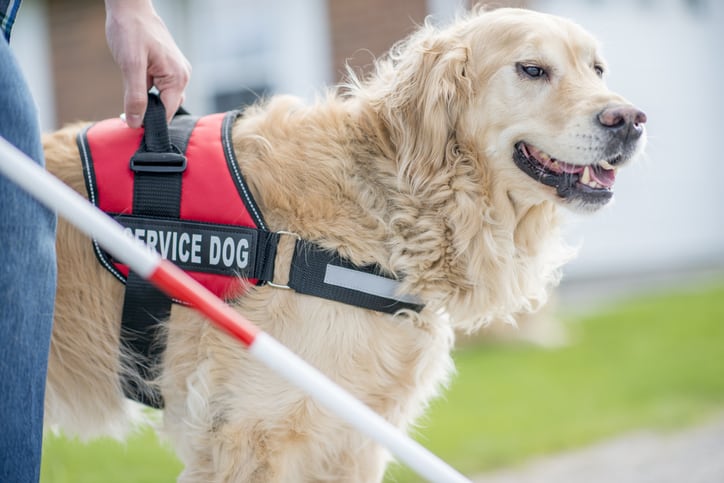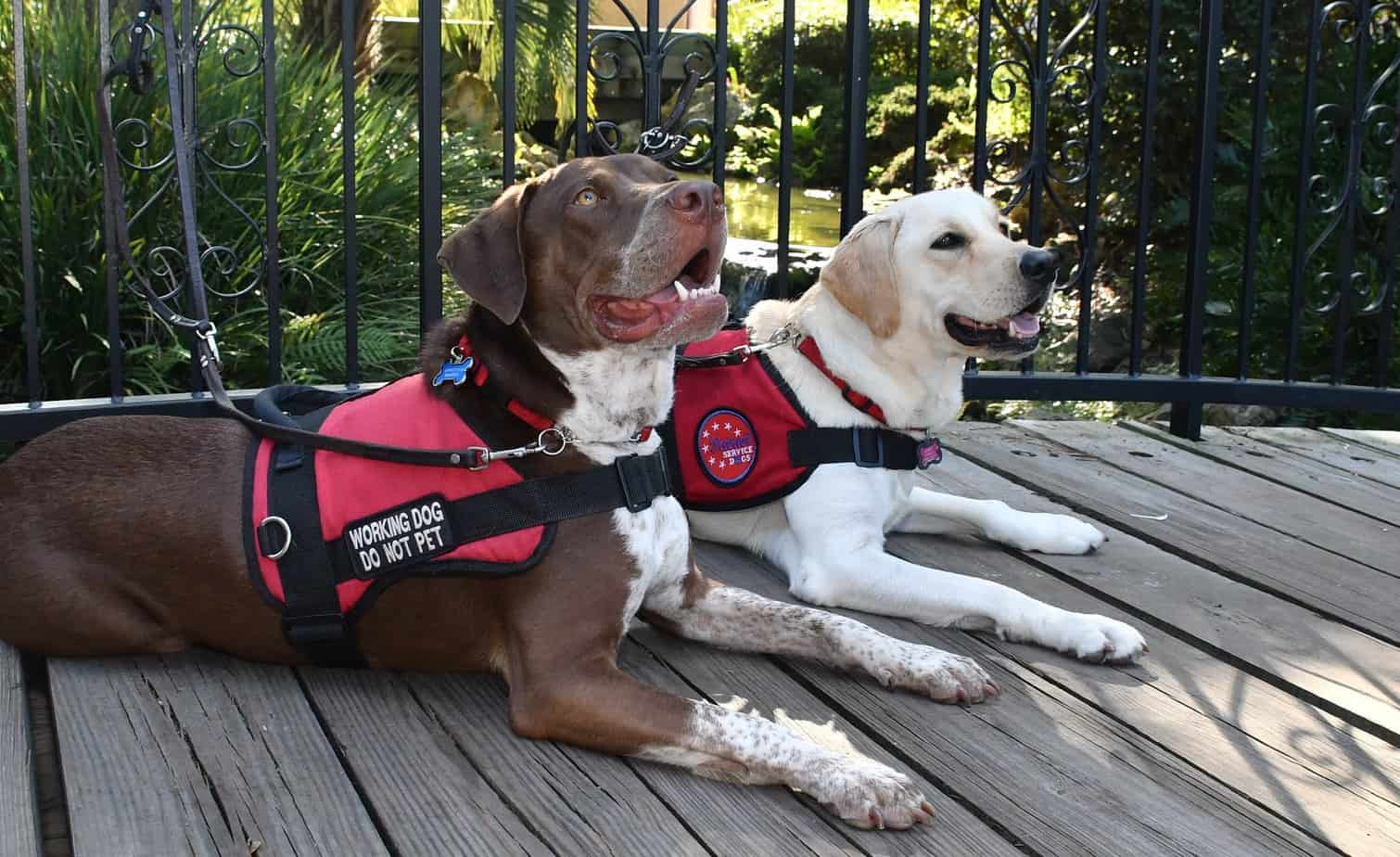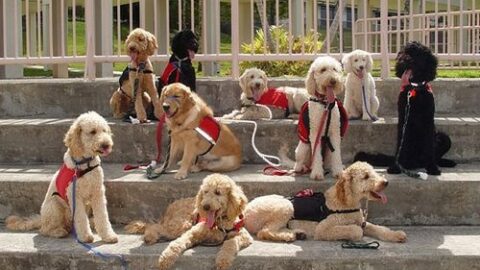- Nom Nom Dog Food Subscription Review - November 7, 2023
- 7 Best Dog Bed Ideas For Great Dane (DIY Options) - July 16, 2022
- Top 5 Rated Best Non-Prescription Diabetic Dog Food - July 15, 2022
A lot of confusion exists regarding how to train your dog to be a service dog, what requirements your dog must meet to be considered a service dog, and what being a service dog actually means. The National Service Animal Registry defines a service dog as any dog “individually trained to do work or perform tasks for the benefit of an individual with a disability, including a physical, sensory, psychiatric, intellectual, or other mental disability.”
Three Different Types of Service Dogs Exist
- A Service Dog is trained to perform daily life tasks for a handler with a physical disability.
- A Psychiatric Service Dog, sometimes also referred to as an Assistance Dog, is trained to perform tasks for a handler who has a disabling mental illness that prevents him or her from performing daily life tasks independently.
- An Emotional Support Dog provides comfort and peace of mind to a handler who is emotionally or psychologically disabled.
Two types of dogs that are not considered service dogs under the Americans with Disabilities Act (ADA) or Fair Housing law are:
Companion Animals

Companions animals are essentially pets, and have no legal protection under ADA. Dogs who fall under this category provide companionship, but do not perform critical daily tasks for a handler, nor are they necessary to support a handler’s mental or emotional health.
Therapy Dogs
Like companion dogs, therapy dogs (sometimes called facility dogs) have no protections under ADA. These dogs are handled by an able-bodied and able-minded person who takes them to hospitals, schools, retirement homes, and other institutions to provide comfort and stimulation to the patients, students, or clients.
Now that we’ve cleared up what types of service dogs exist, how do you know if your dog would be a good candidate? Well, it’s really pretty simple. Absolutely any breed of dog can become a service dog. Much more important than your dog’s breed are her temperament and her health. If you believe your dog’s temperament and health would be conducive to a role as a service dog, the two of you must go through three basic steps: training, testing, and registration.
Temperament
Before you and your dog embark on the training needed to become a service dog, you need to make sure your dog’s personality fits the bill. If you do not know the breed of your dog, one way to learn about her temperament and instinctual tendencies is with a DNA test, which can provide insight into specific breeds’ typical behaviors and traits. One of the most reliable DNA tests available can be purchased on Amazon (see below).
Although your dog can become a service dog at any age, make sure she is beyond the too-playful puppy phase. She needs to be able to remain focused and calm, even amongst many distractions and lots of stimulation.
It’s also a good idea to assess whether your dog leans toward aggressive or submissive. The appropriate temperament for a service dog is one that is “calm, cool, and collected, but also alert and responsive.” If your dog ever displays any unprovoked aggression, “service dog” is probably not the right role for her.
No products found.
Health
Dogs can become service dogs at any age, but you do want to make sure your dog is at least six months old. Heading to the vet for a routine physical is also a good idea, as some conditions, such as arthritis or heart conditions, can make working as a service dog difficult–or even dangerous–for your dog.
Finally, your dog should be fixed before becoming a service dog to decreases aggression in males and prevent females from having to work while in heat.
Types of Service Dogs

Service Dogs
Service dogs are those dogs trained to help people with disabilities perform daily life tasks. Because these dogs will need to be able to complete many tasks, they require task-training to do things like open and close doors, retrieve shoes, etc. The tasks the dogs learn to complete will directly correlate to her handler’s needs. Because a service dog is viewed as integral to a handler’s ability to perform basic necessary tasks, under ADA, a service dog is allowed anywhere a person is, from shopping malls to movie theaters, from buses to airplane cabins. Under ADA, a service dog and her handler must be permitted to stay together, and a handler cannot be charged any additional fees for bringing a service dog along.
Psychiatric Service Dogs
A psychiatric service dog must be prescribed by a licensed therapist, and under ADA, can go anywhere her handler goes, including “no pet” housing and airplanes (for free!). Some possible tasks a psychiatric service dog might perform could include:
- Locating an exit for a handler prone to panic attacks
- Redirecting a handler with Obsessive Compulsive Disorder from engaging in OCD behaviors, such as picking at skin, pulling at hair, etc.
- Help a handler who suffers from hallucinations identify whether something is real or a hallucination.
Emotional Support Dogs
Like psychiatric service dogs, emotional support dogs must also be prescribed by a therapist. These dogs are trained to help handlers with mental health issues. No task-training is required for emotional support dogs, because they do not perform daily life tasks, but are therapeutic through their presence.
Under ADA, emotional support dogs can fly in the cabin of an airplane with a handler at no charge, if the handler notifies the airline ahead of time and provides the airline with a detailed letter from a therapist, explaining the purpose and necessity of the dog.
Under Fair Housing law, even if a property does not permit pets, property managers and landlords must allow emotional support dogs to live with their handlers, but may require a letter from the therapist, a prescription, and additional fees.
Training
Once you’ve determined your dog possesses the right temperament and health for a role as a service dog, and have decided what kind of service dog she should be, you can train her yourself, but because the training for service dogs is so specific, working with a professional trainer is best.
Standard requirements for training include at least 120 hours over a period of at least six months. Thirty of the 120 hours need to be spent out in public, with hazards, distractions, and obstacles.
Training typically consists of three phases:
- Heeling. This refers to teaching your dog to maintain a specific position relative to your own (or any handler’s) body position.
- Proofing. This refers to teaching your dog to always be on task and working (AKA on command), regardless of circumstance and distractions.
- Tasking. Perhaps the most challenging phase of training, tasking refers to teaching your dog the specific tasks he will need to perform for his handler, which will vary according to the type of service he will provide and the type of person to which he will provide it.
Beyond the three basic training phases, several training standards exist depending on the type of service dog your dog will become:
- Training standards for service dogs
- Training standards for guide (seeing eye) dogs
- Training standards for hearing dogs.
Public Access Test
After you and your dog have completed the training requirements, your dog needs to pass the Public Access Test, administered by various organizations. In the case of the Assistance Dogs International Public Access Test, the test must be administered by a member of the ADI. Some basic requirements your dog must meet are:
- no aggression (growling, biting, or barking)
- no potty breaks during the test
- no excessive sniffing
- no begging (for food or attention)
- calm, cool demeanor; self-control.
The National Service Animal Registry also administers a Public Access Test for Service Animals, as well as a Public Access Test for Emotional Support Animals. Some of the requirements include that your dog:
- “Walk beside you without straining against the leash
- Sit on command
- Come when called
- Lie down on command
- Show no aggression toward humans or other animals when unprovoked.”
Registration
Registration of your service dog is not required by law in the U.S., and is self-regulated, but there are several good reasons to register your dog as a service animal once she has completed her training and passed her Public Access Test:
- Registration is the responsible thing to do.
- Registration helps “ensure canine competency.”
- Registration can help protect and support you and your dog if there is ever a question as to her qualifications and/or training.
- Registration can help mitigate disputes from the public or business owners who may otherwise not want to grant your service dog permission to accompany you.
Essentially, registering your dog validates her as a service dog, and helps guarantee the ADA and Fair Housing law protections granted to service animals. There are multiple places you can register your service dog, two of them being National Animal Service Registry (NASR) and United States Service Dog Registry.
Giving Back
When you decide to help your dog become a service dog, you can complete the three basic training phases yourself, or work with a professional trainer. Your dog can train to become a service dog, a psychiatric service dog, or an emotional assistance dog, all of which are recognized by and protected under ADA and Fair Housing law. Companion dogs and therapy dogs are not legally recognized as service dogs.
Training your dog to become a service dog is one way you can give back – and allow your dog to play a meaningful, helpful role.
Continue reading:




